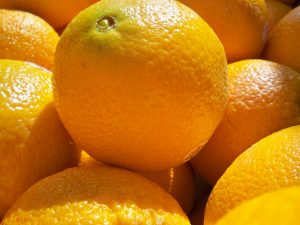Oranges at Christmas
Here is another of our Christmas classics: Paul Marion’s “Oranges at Christmas.”
Oranges at Christmas
By Paul Marion
This week, my wife, Rosemary, bought a bag of small navel oranges at Market Basket, the first of these babies for the season. When I opened the plastic bag the twelve baseball-sized oranges spilled over the counter, and the scent of orange oil filled the kitchen. I look forward to the first seedless oranges from the tropical groves along the Pacific or Gulf coasts. If I didn’t know better, I’d picture ripe oranges pulling down the fronds of palm trees in the sun.
I was lucky enough to live in Southern California one year during the growing season. In fact, one night driving south on the San Diego Freeway near the old mission at San Juan Capistrano I passed a vast orange grove in blossom, the scent of orange flowers ten times more powerful than the apple blossoms I’d grown up with in the Merrimack Valley. Some of the blooming orange trees still had fruit hanging off the branches. The idea of walking into a backyard in Laguna Beach and picking an orange or a lemon off a tree seemed impossibly exotic to a New Englander. A pear or a peach, yes, but tropical fruit along the driveway? No way.
The incredible special bounty of a giant navel orange from far away probably explains why my parents thought of it as enough of a gift to stuff a couple in Christmas stockings for my brothers and me when we were young. On Christmas morning you could count on finding one or two in with a few novelty toys and candy canes and maybe a new pair of gloves.
The oranges at Christmas come to us by way of Saint Nicholas, yes, the same as in “the stockings were hung by the chimney with care in hope that St. Nicholas soon would be there,” according to the St. Nicholas Center on the Web. The original Nicholas was a fourth-century Christian in what is now southern Turkey who was known for helping the poor. One legend has Nicholas tossing small bags of gold through open windows at night into the shoes of young women who needed dowry money to get married. This is the source of the Christmas stocking tradition—those long red socks hung by the fireplace the night before Christmas in hope of being filled with gifts in the morning. Nicholas’s bag of gold became a ball of gold as the story evolved—and the ball of gold turned into an orange stuffed into the toe of the stocking. There it is.
In western Canada there’s an age-old Christmas tradition in British Columbia beginning with the delivery of the first batch of mandarin oranges from Japan. The Vancouver festival combines Santa Claus and Japanese dancers. Bright as light bulbs on the kitchen table, the oranges promise sunshine as late December daylight shrinks in the shortest days of the year.
With each successive winter week the navel oranges from California get better and bigger, until the harvest season passes. Then it’s back to the Valencias from Florida, the oranges with seeds, the juice oranges, not the eating oranges with the thick spongy skin that peels off like wrapping.
So the oranges are old gold, and the fruit is a nod to Saint Nick. People sometimes do things because they’ve always done them or they may do things for reasons of their own that have nothing to do with the reason other people do those same things.
My parents never talked about Nicholas and his golden gifts seventeen hundred years ago. They never talked about the kids in Europe who left their shoes and socks by the fireplace on Christmas Eve hundreds of years later. In the Great Depression of the 1930s, when my folks were growing up in Lowell, Massachusetts, an orange was a treat in a poor family. When my folks put oranges in our stockings later on it was their own kind of gold that they were giving us. I told my son he’d get one this year if we’re lucky.
—Paul Marion (c) 2010
